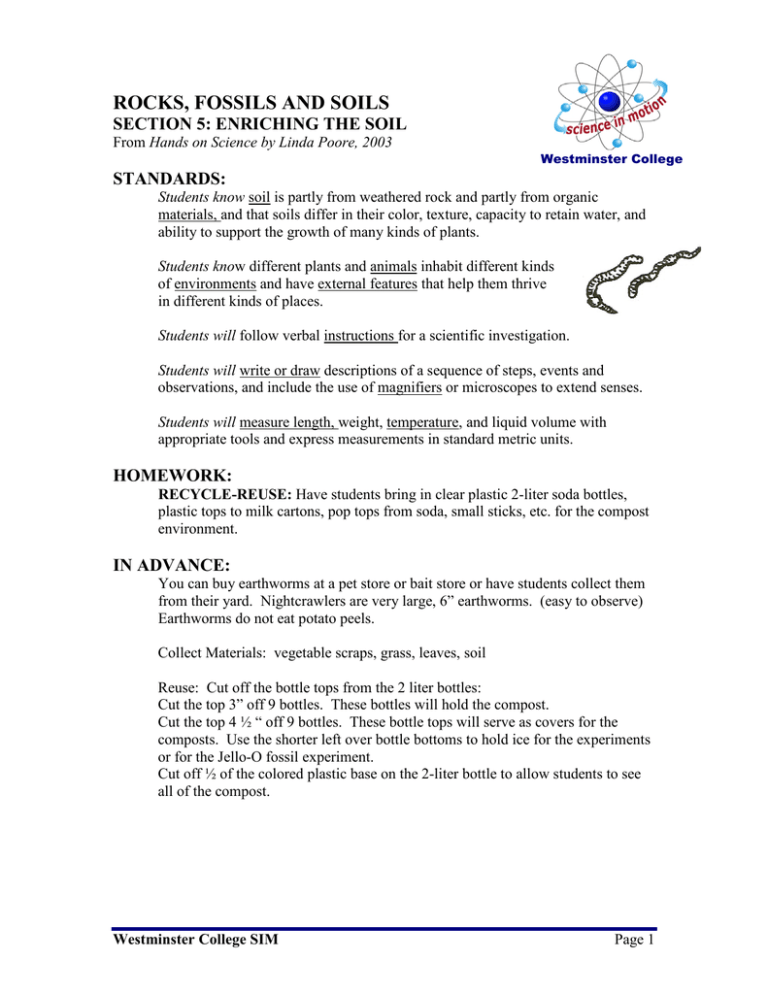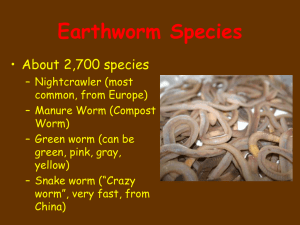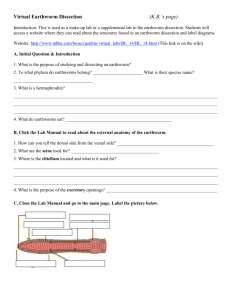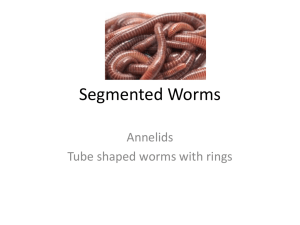ROCKS, FOSSILS AND SOILS SECTION 5: ENRICHING THE SOIL STANDARDS:
advertisement

ROCKS, FOSSILS AND SOILS SECTION 5: ENRICHING THE SOIL From Hands on Science by Linda Poore, 2003 Westminster College STANDARDS: Students know soil is partly from weathered rock and partly from organic materials, and that soils differ in their color, texture, capacity to retain water, and ability to support the growth of many kinds of plants. Students know different plants and animals inhabit different kinds of environments and have external features that help them thrive in different kinds of places. Students will follow verbal instructions for a scientific investigation. Students will write or draw descriptions of a sequence of steps, events and observations, and include the use of magnifiers or microscopes to extend senses. Students will measure length, weight, temperature, and liquid volume with appropriate tools and express measurements in standard metric units. HOMEWORK: RECYCLE-REUSE: Have students bring in clear plastic 2-liter soda bottles, plastic tops to milk cartons, pop tops from soda, small sticks, etc. for the compost environment. IN ADVANCE: You can buy earthworms at a pet store or bait store or have students collect them from their yard. Nightcrawlers are very large, 6” earthworms. (easy to observe) Earthworms do not eat potato peels. Collect Materials: vegetable scraps, grass, leaves, soil Reuse: Cut off the bottle tops from the 2 liter bottles: Cut the top 3” off 9 bottles. These bottles will hold the compost. Cut the top 4 ½ “ off 9 bottles. These bottle tops will serve as covers for the composts. Use the shorter left over bottle bottoms to hold ice for the experiments or for the Jello-O fossil experiment. Cut off ½ of the colored plastic base on the 2-liter bottle to allow students to see all of the compost. Westminster College SIM Page 1 ENRICHING THE SOIL MATERIALS: For Each Team of 4 1 liter bottle with lid (see in advance) soil leaves or grass clippings vegetable scraps (not potato peels) pieces of plastic and metal (lids form milk cartons, pop tops from soda) seeds (section 4) EXPLORE: CAN WE RECYCLE GARBAGE TO ENRICH THE SOIL? ORGANIC MATERIAL IS BROKEN DOWN TO BECOME SOIL 1. Have students make a compost to show how plant materials decay, enriching the soil. Use 2-liter plastic soda bottles with the tops cut off as containers. Layer 1” of soil, 3”-4” of leaves or grass clippings, and 1” of vegetable scraps. Repeat layers. (see diagram) Place vegetables against the plastic so they can be observed. Do not use any animal scraps (beef, lunchmeat, etc.) Water to moisten thoroughly and cover with the larger bottle tops. 2. Add water when no condensation appears inside lid to keep the compost damp. Observe each week for changes. Which food disappeared first? When do all the vegetables disappear and become part of the soil? 3. WHAT HAPPENS TO THE GARBAGE? Mold, fungi, insects, and bacteria decompose organic materials, returning minerals to the soil. How could this help our garbage problem? (more room in the dump) Could you recycle vegetable garbage at home? (yes) 4. Plant seeds in compost bottles and observe growth. 5. After 1 or 2 months, go outside and dump each compost’s contents on a separate newspaper. Use a pencil or stick to look through the soil. What items are still whole? (plastic, metal, wood) Can you find any vegetables or fruit? What happened to them? (Used for food by bacteria, fungi, and mold.) HOMEWORK: FAMILY SCIENCE Give each student a copy of the following directions: Westminster College SIM Page 2 ENRICHING THE SOIL Put 1” of moist on the bottom of a plastic zip-lock bag, add an apple core or any small piece of vegetable or fruit so you can see it through the bag. Add soil on top. Dampen the soil and seal the bag. Moisten soil whenever the bag does not show condensation (water drops). Observe. Write today’s date on the bag. When does the food disappear? Keep a journal describing changes that occur. Date each entry. MATERIALS: Earthworms in plastic trays magnifiers several cups of water crayons EXPLORE: HOW DO EARTHWORMS CHANGE THE SOIL? 1. WORKSHEET, My Earthworm Report can be filled out individually or together as students share their findings. Show students how to use the ruler. They can place the paper ruler under the plastic tray to measure the earthworm. 2. OBSERVING EARTHWORMS Give each pair of students 1 earthworm on a plastic tray and a magnifying glass. Moisten the worm frequently during observations. Let the students explore and discover using the magnifier. Measure the earthworm’s length and width. How does the skin feel? (wet, soft) Worksheet answers: Does your earthworm have eyes, ears, legs, nose, mouth, or stripes? (only a mouth and ‘stripes’ that divide it into segments) How many lines do you think are on the body? (150) How can you tell the front end from the back end? (It moves forward. The front end is round and the back end is pointed.) Can you tell the top from the bottom? (bottom is flat, top is rounded) 3. HOW DOES THE EARTHWORM MOVE? It stretches one part out while it squeezes another part together. Westminster College SIM Page 3 ENRICHING THE SOIL It has 4 bristles called setae on every segment except the first and last to help it move. They look like hairs and are along the bottom. They help anchor one segment as another area extends or contracts. It is hard for a bird to pull an earthworm out of a hole because the bristles help the earthworm hold onto the dirt. You can feel the bristles move when you hold the earthworm. 4. EXPERIMENT: Can Earthworms climb a hill? Tilt the tray at an angle. Does the earthworm slip? How steep a slant can the earthworm move up? Have students tilt their trays after they experiment, to show you the angle their worm can climb. 5. EXPERIMENT: Will the earthworm go around an object? Put an obstacle (crayon) in front of your earthworm. What does it do at the crayon? (go over, under, or around it) Place the worm in front of the crayon several times. Discuss. Remind students to sprinkle some drops of water of their worm. 6. EXPERIMENT: Does the earthworm like the sides or the middle of the container? Put the earthworm in the middle of the container. Watch the earthworm for 2 minutes. Where is it now? Put the earthworm along the side of the container. Watch for 2 minutes. Where is it after 2 minutes? (Earthworms prefer sides.) ASSESSMENT: Write 5 things you learned about earthworms. NOTE: Earthworms aerate soil, adding space and air pockets as they eat the organic materials, breaking them down to basic minerals that are returned to the soil for plants to use. They are hermaphrodites, meaning they have both sperm and egg. They do join at the clitellum to share sperm with another earthworm. Later, they push the sperm over the eggs in an egg case. Earthworms have 4 hearts and over 150 segments. Earthworms can only breathe through wet skin. They come to the surface of the ground when it rains. The rain fills the air pockets in the soil and they have no air. EARTHWORMS HELP FARMERS An acre of land can contain 50,000 earthworms, that overturn 18 tons of soil a year, improving the chemical composition and allowing air and water to pass more readily. Westminster College SIM Page 4 ENRICHING THE SOIL NOTE: To meet the CA Science Standard, the second grade students use metric units, measuring in Celsius. If the thermometer has both Fahrenheit and Celsius scales, you can hid the ‘°F’ side to make it easier for students to remember to use Celsius by using the sticky edge of a Post-it® over the ‘°F’ side. USING EQUIPMENT: USING THERMOMETERS: Make a transparency of the thermometer scale and use it to show students how to read the thermometer. (picture of the scale at the end of this section) Pass out thermometers. Discuss how to read the thermometer scale in Celsius What is each line on the thermometer worth in Celsius? (1 degree) What is the temperature of the room? MATERIALS: lamp bulb foil earthworms thermometers black paper cup paper towels ice trays EXPLORE: WHAT ENVIRONMENT DO EARTHWORMS LIKE? 1. Have students: Design experiments to test the reaction of earthworms to light vs. dark, wet vs. dry, and cold vs. hot. Draw or write their experiment design. Assign different teams to try each experiment. Compare the results of different teams. Remember to keep earthworms damp. Short experiments of a few minutes work best. Compare student ideas to the three worksheet experiments (at the end of this section) Westminster College SIM Page 5 ENRICHING THE SOIL 2. MORE EARTHWORM EXPERIMENTS Use the 2 worksheets testing what earthworms like. (end of section) To test temperature: Fold a 3’ x 12” piece of aluminum foil into a 4” x 3’ long tray. (see diagram) Put worms on the aluminum tray with a light bulb under one end (heat) and ice cubes under the other. Measure the temperature at different spots along the tray’s length. Where should you put the worms to start the test? (in the middle?) Where are the worms after 5 minutes? Do worms prefer hot, warm or cold? How many times should you repeat the experiment to be sure? (5) The aluminum tray you made can be used with wet/dry and dark/light experiments. Save these ‘tray’s for the next year. ART: EARTHWORM PAINTINGS 1. Put 3 drops each of red, blue, and yellow food coloring on white paper. 2. Dip the earthworm in a bowl of water quickly to clean off the dirt. Place an earthworm on the colored drops and watch it paint. If you lift and move the worm, you will get segment prints on your paper or Dip an earthworm quickly in tempera paint (runny, not thick) and then place the earthworm on your paper. 3. Look at the painting, Can you see the segments of the earthworm? 4. Return the earthworm to moist soil. (Earthworms do not need a bath.) EXPLORE: HOW DO EARTHWORMS ENRICH THE SOIL? 1. Add earthworms to your compost. ( in 2-liter bottles) To observe their tunnels, place a block of wood in the center of the bottle, so earthworms stay near the bottle sides. Cover the bottle with black paper and keep the soil moist. Add several tablespoons of coffee grounds and 2 tablespoon of brown sugar for food for the earthworms. 2. Earthworms eat organic material like leaves, breaking it into smaller pieces. They return minerals from the food they eat to the soil through excretion. They aerate soil (add air and space) so that water can percolate easily through the soil. Westminster College SIM Page 6 ENRICHING THE SOIL Westminster College SIM Page 7 ENRICHING THE SOIL Westminster College SIM Page 8 ENRICHING THE SOIL Westminster College SIM Page 9 ENRICHING THE SOIL Westminster College SIM Page 10




